100-year-old house that the Peredos built

AURORA Peredo-Calaguas, the only surviving child of Roque and Rita Peredo, grew up in this house her parents built from 1914 to 1915. Below is the 100-year-old house’s living room, where the Peredo family built memories in the summer capital. PHOTOS BY RICHARD BALONGLONG

They would have wandered toward No. 1 Navy Base Road to marvel at a two-story wooden house in the neighborhood.
This house survived the American bombers which flattened Baguio when it liberated the city from the Japanese Imperial Army during World War II. It has remained standing after the July 16, 1990 earthquake devastated Baguio and other parts of northern and central Luzon.
On Dec. 28, the house which Roque and Rita Peredo built in 1915 turned a century old, drawing back old families from Baguio and other parts of the country who spent part of their youth in that house.
Roque was a professional draftsman, who was studying to be an engineer, when he decided to build a home for his growing family in 1914. The couple had 11 children.
Article continues after this advertisementThe Peredo house was built by Japanese and Cordillera craftsmen and carpenters and was filled with the sound of children’s laughter, said Aurora Peredo-Calaguas, the only surviving child of the Peredo couple.
Article continues after this advertisement“Can you imagine, we were 11 siblings, running around the house? We used to slide on pine needles here. The yard used to have a lot of pine trees,” said Calaguas, 80, who relatives call “Tita Petite.”
She said the house used to extend up to Leonard Wood Road until the family sold parcels when her father fell ill.
Too much has changed since then, Calaguas said. “When we were kids, we played along the creek [near the house]. It was clean then. Look at it now—so dirty and smelly,” she said.
Lodging house
To locals and visitors, the house has always been Peredo’s Lodging House.
In the early 1950s, as residents began rebuilding after the war, the Peredo family rented the house to some of the more prominent Baguio families at the time, like the Prietos and Roceses.
These families stayed in the Paredo house until they rebuilt their houses, Calaguas recalled.
“We started renting the house [full time] when we could no longer afford the taxes. Now that it is a lodging house, it takes care of its own maintenance [expenses],” she said.
The house is now owned and managed by the Peredo’s Lodging House Inc., a family corporation that Calaguas chairs.
New problems
Dedicating their house to lodgers opened up new problems, Calaguas said. For instance, it required more bathrooms.
Instead of building a bathroom for each room, the family chose to extend the structure to accommodate more bathrooms to retain the house’s original design, Calaguas said.
She said her parents would not have wanted the house altered in any way.
Loretta Ann Peredo-Rosales, former chair of the Commission on Human Rights, is the second oldest grandchild of Rita and Roque Peredo.
In a book about the Peredo family, Rosales wrote a chapter describing how the Japanese took over the Peredo house and turned it into their officers’ quarters during the war.
The Peredo family left Baguio when the war broke out. But one of Calaguas’ brothers stayed behind, Rosales said.
“Tio Jose stood guard and never left No. 1 Navy Base Road…. Today, the only visible sign of the war in the house is a shrapnel hole at a corner where the living and dining room light switches are found,” she said.
Calaguas said, “We recovered the shrapnel that hit the house. The damage was very minor.”
Sanctuary
During the martial rule of the late strongman Ferdinand Marcos, the Peredo house served as sanctuary for activists, Rosales said. “Meetings were held in the house, which gave protection to those whose lives stood in danger of arrest and detention,” she said.
In 1990, after the earthquake, Rosales said the house served as sanctuary for friends and relatives whose homes were destroyed.
Last week, the National Museum of the Philippines installed a marker declaring Peredo’s Lodging House an “important cultural property.”
“The grandeur and timelessness of our ancestors’ architecture and carpentry genius had been immortalized in historical books. But being able to see their actual work is the best description and educational tool for the younger generation,” said Racquel Flores, National Museum curator.